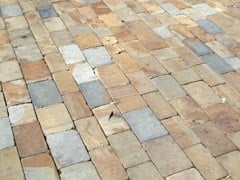The time of tests
Led by Europe, more tests are being devised all the time to try to evaluate stone. Here and in future editions of NSS, Barry Hunt explains the procedures and discusses what the results show… and what they don’t.
What is the most useful stone test and why?
There are many different tests available that can be applied to a wide variety of uses of stone. Each test might give you an answer that is key to helping solve a particular problem or provides an insight into how a material might perform in a given environment.
However, taken out of context, a test result might also be the foundation for disaster, such as when a stone deemed to be frost resistant fails because the test could not take into account the many different factors involved in real life.
Test results can also become obsolete as a resource is tapped, even though such changes are not apparent in the look of the material.
I must admit, I really do not like many tests because they can be so misleading.
This especially applies to all those tests that try to predict durability. None of them really works or can be relied on without question.
Coming from someone who has spent a large proportion of their life testing, this must seem odd. But I wince every time I put pen to paper to interpret test results, trying to give my best advice. I think it is unfortunate that we are driven by the need to provide quantifiable results and certification for natural stone in all its innate variation, but the unwitting in construction need something to grasp on to, if only for the purposes of insurance.
On a more positive note, without testing we would not be able to push the boundaries of stone’s use, making it more available to all and helping to reduce waste, thus making better use of each individual finite resource.
My favourite test is straightforward, although it is not written into any standard. It is simply: visual examination.
I must add the caveat that this is only worthwhile if the observer is knowledgeable with a strong grounding in the geological sciences, otherwise many issues may simply be overlooked.
Quarries have an incredible amount of information to offer, but it is seldom properly tapped. Weathering profiles, jointing and faulting structures, intrusion, localised metamorphism, hydrothermal changes, sedimentary megastructures such as channels… the list of things you can see goes on and on.
All this visual information can help determine whether a stone can be prepared in a particular way for a particular use. All other testing should be secondary.
Observation of the previous use of a material and how it has performed also provides much good information, although, again, such inspection is quite useless in the hands of someone unable to interpret the information correctly and relate it to the current supply and use.
I am often given pieces of stone and asked to give an immediate opinion on what I think. The feeling of its mass, a scratch with a knife, a lick of the surface for taste (quite a nasty geologist’s habit), a tap with a hammer, maybe a drop of acid (a descaler such as hydrochloric) and a strong opinion can be formed.
But it is the response to the mineral assemblage and therefore the perceived geology… the visualisation of the resource… past experience of stone use… These are what drive the opinion given. Other tests available only affirm the instinctive but considered opinion.
This can be seen to be a dangerous pre-judgement that is ultimately non-scientific, but that is the nature of much that is geological. You inevitably feel as if you have to take a bit of a leap of faith.
Good observation and common sense can get the layperson a long way with stone. Then tests start to confuse the issue, mainly because there is no easy way for the layperson to interpret the results.
This is because good research is woefully lacking and many of the tests available are adaptations of tests applied to manufactured materials that are difficult to apply to natural stone.
It is for these reasons that I am going to devote forthcoming issues of this column to each of the principal stone tests available. I shall explain how they are carried out, what information is obtained from them and how this can be used. I shall also point out the potential pitfalls.
European regulation is driving us towards more testing, so let’s at least try to make better sense of it.

